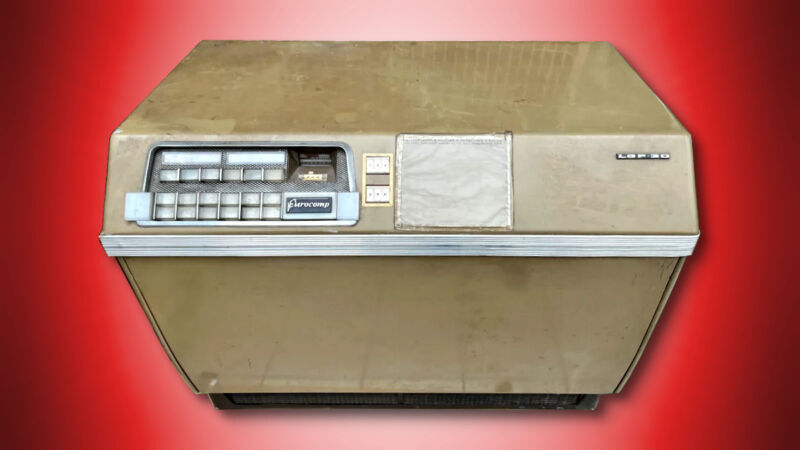
Enlarge / The LGP-30 computer, from 1956, that a Redditor found in a basement. (credit: c-wizz)
On Monday, a German Redditor named c-wizz announced that they had found a very rare 66-year-old Librascope LGP-30 computer (and several 1970 DEC PDP-8/e computers) in their grandparents' basement. The LGP-30, first released in 1956, is one of only 45 manufactured in Europe and may be best known as the computer used by "Mel" in a famous piece of hacker lore.
Developed by Stan Frankel at California Institute of Technology in 1954, the LGP-30 (short for "Librascope General Purpose 30") originally retailed for $47,000 (about $512,866 today, adjusted for inflation) and weighed in at 800 pounds. Even so, people considered it a small computer at the time due to its desk-like size (about 44×33×26 inches). According to Masswerk.at, the LGP-30 included 113 vacuum tubes, 1,450 solid-state diodes, and rotating magnetic drum memory—a 6.5-inch diameter and 7-inch long tube rotating at 3,700 RPM—that could store 4,069 31-bit words (equivalent to about 15.8 modern kilobytes).
Along with the main LGP-30 unit, c-wizz found a Flexowriter typewriter-style console (used for input and output with the machine) and what looks like a paper tape reader for external data storage. A few PDP-8/e machines and some related equipment lurked nearby. "There seem to be more modules belonging to the PDP/8E's as well," c-wizz wrote in a Reddit comment. "There is a whole 19-inch rack where all of this is supposed to be mounted in. Maybe I can find some manuals and try to put it all together."
Read 4 remaining paragraphs | Comments

Enlarge / The LGP-30 computer, from 1956, that a Redditor found in a basement. (credit: c-wizz)
On Monday, a German Redditor named c-wizz announced that they had found a very rare 66-year-old Librascope LGP-30 computer (and several 1970 DEC PDP-8/e computers) in their grandparents' basement. The LGP-30, first released in 1956, is one of only 45 manufactured in Europe and may be best known as the computer used by "Mel" in a famous piece of hacker lore.
Developed by Stan Frankel at California Institute of Technology in 1954, the LGP-30 (short for "Librascope General Purpose 30") originally retailed for $47,000 (about $512,866 today, adjusted for inflation) and weighed in at 800 pounds. Even so, people considered it a small computer at the time due to its desk-like size (about 44×33×26 inches). According to Masswerk.at, the LGP-30 included 113 vacuum tubes, 1,450 solid-state diodes, and rotating magnetic drum memory—a 6.5-inch diameter and 7-inch long tube rotating at 3,700 RPM—that could store 4,069 31-bit words (equivalent to about 15.8 modern kilobytes).
Along with the main LGP-30 unit, c-wizz found a Flexowriter typewriter-style console (used for input and output with the machine) and what looks like a paper tape reader for external data storage. A few PDP-8/e machines and some related equipment lurked nearby. "There seem to be more modules belonging to the PDP/8E's as well," c-wizz wrote in a Reddit comment. "There is a whole 19-inch rack where all of this is supposed to be mounted in. Maybe I can find some manuals and try to put it all together."
Read 4 remaining paragraphs | Comments
November 09, 2022 at 04:32AM

Post a Comment